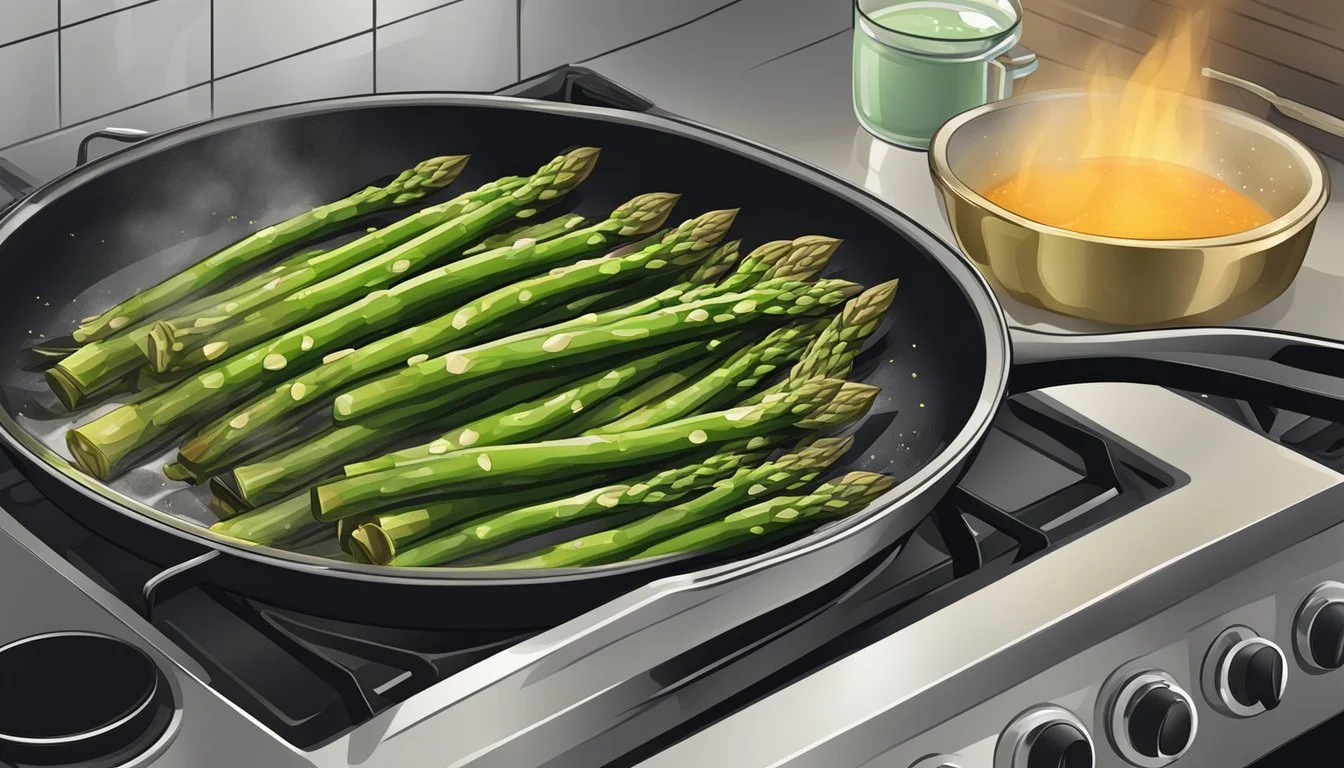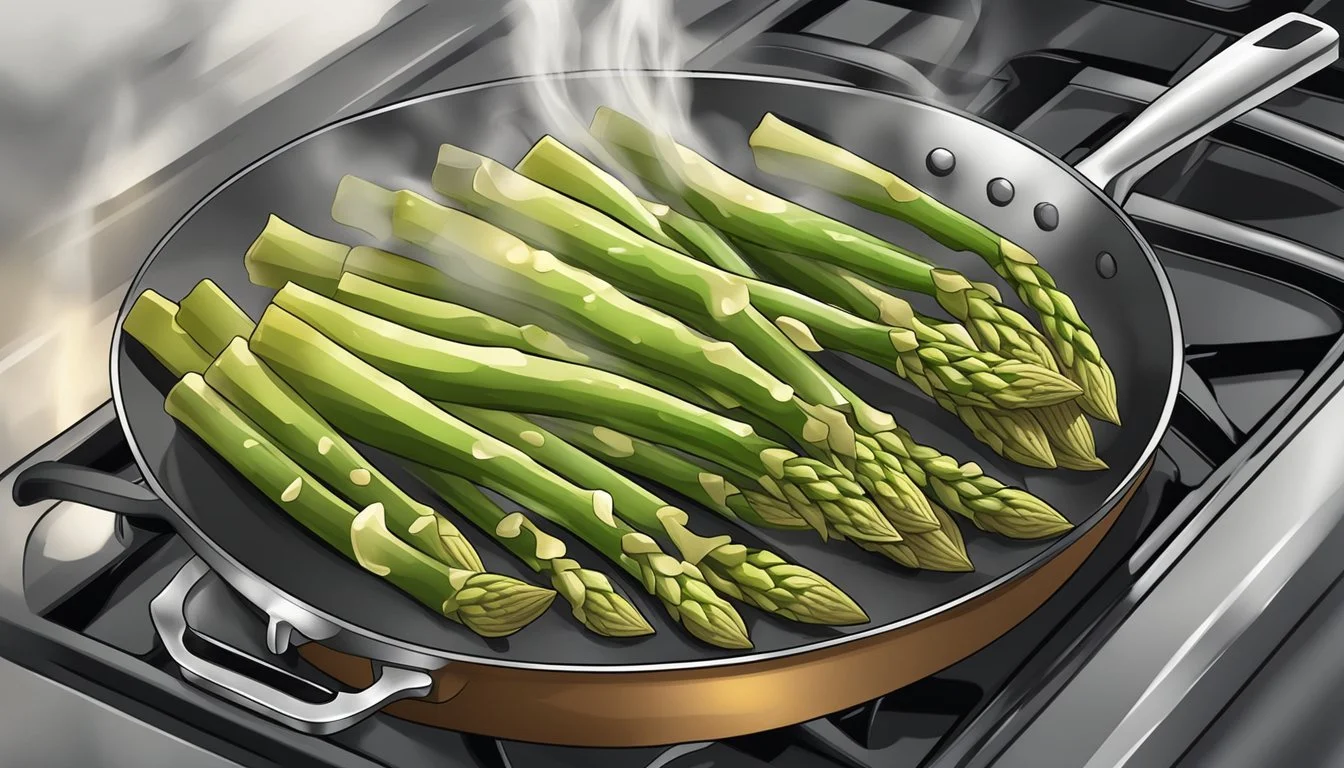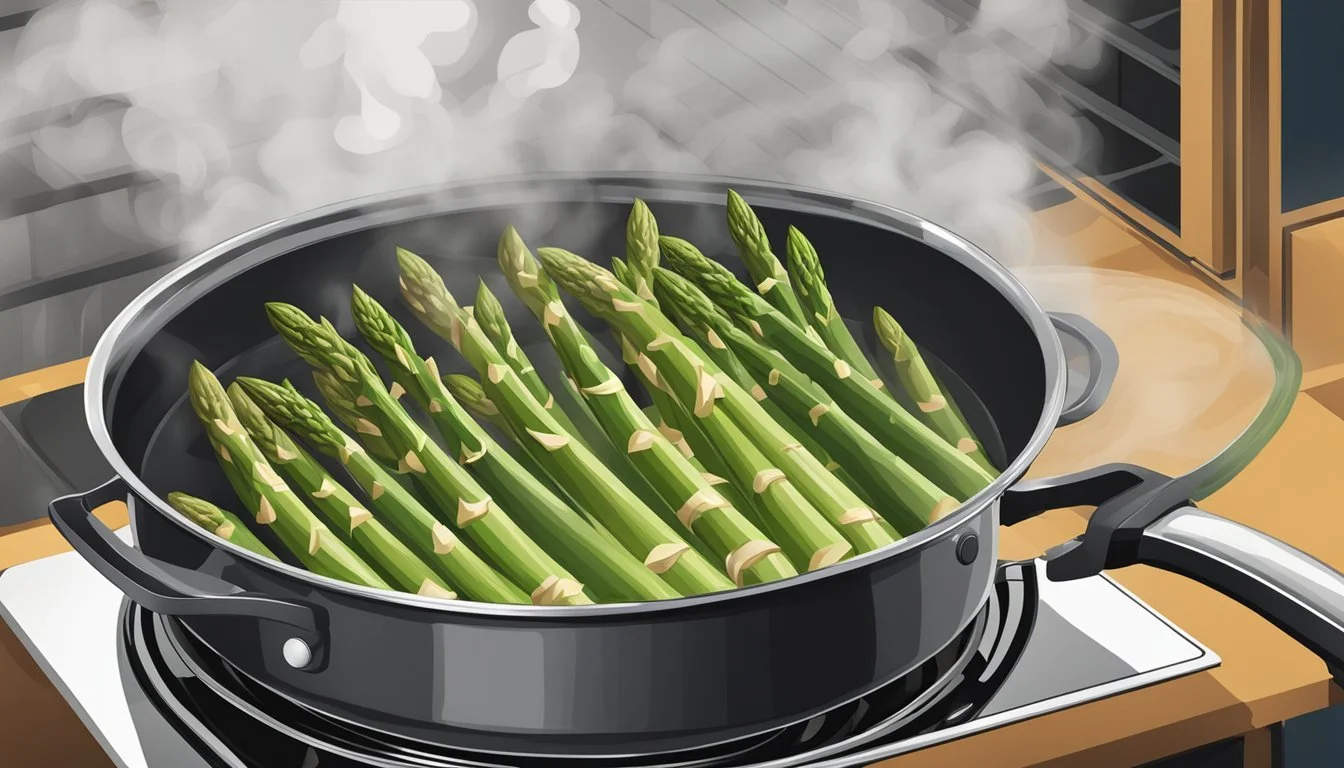How to Cook Asparagus on the Stove
Quick and Easy Methods for Perfect Spears
Cooking asparagus on the stove is a quick and easy way to prepare this nutritious spring vegetable. Pan-frying or sautéing asparagus takes only 10-15 minutes and results in tender, crisp spears with delicious flavor. This simple cooking method brings out the best in fresh asparagus while preserving its bright green color and natural sweetness.
Asparagus can be cooked on the stovetop using minimal ingredients for a healthy side dish. A touch of butter or olive oil, along with garlic and lemon, complements the vegetable's earthy taste. The key is to avoid overcooking, which can lead to mushy texture and diminished nutrients.
Selecting fresh asparagus is essential for the best results when cooking on the stove. Look for firm stalks with tightly closed tips and vibrant green color. Trim the woody ends before cooking to ensure tender spears from tip to base. With these tips in mind, anyone can master stovetop asparagus preparation.
Selecting Quality Asparagus
Choosing the right asparagus is crucial for a delicious dish. Look for spears with vibrant color and firm stems to ensure freshness and flavor.
Identifying Freshness
Fresh asparagus has bright green or violet-tinged spears. The tips should be tightly closed and compact. Avoid spears with dry or split ends. Check the cut ends - they should appear moist and not woody.
Squeeze the bunch gently. Fresh asparagus will feel firm and squeak slightly. Avoid limp or mushy spears. The skin should be smooth and free from blemishes or discoloration.
Store asparagus upright in water, like flowers in a vase. Cover loosely with a plastic bag and refrigerate. Use within 3-4 days for best quality.
Thick vs. Thin Asparagus
Asparagus comes in various thicknesses. Thick spears are generally more tender and have a meatier texture. They're ideal for grilling or roasting.
Thin asparagus cooks quickly and is perfect for stir-fries or light sautéing. It has a delicate flavor and crisp texture.
Choose based on your cooking method and personal preference. Thick spears may need peeling near the base to remove tough outer skin.
Ensure all spears in a bunch are similar in thickness for even cooking. Mix sizes only if you plan to cook them separately.
Prepping Asparagus for Cooking
Proper preparation is key to enjoying delicious asparagus. Trimming and cleaning the spears ensures optimal texture and flavor when cooked.
Trimming the Woody Part
Asparagus stalks have a tough, fibrous end that needs removal before cooking. Hold each spear at both ends and gently bend until it snaps naturally. This breaking point separates the tender upper portion from the woody base.
Alternatively, line up the spears and trim about 1-2 inches from the bottom with a sharp knife. This method works well for uniform presentation.
For thicker spears, consider peeling the lower half with a vegetable peeler. This technique removes any remaining tough outer layers, resulting in more tender asparagus.
Washing and Drying
Rinse asparagus spears under cool running water to remove any dirt or debris. Pay special attention to the tips, where grit can hide.
Gently shake off excess water. Pat the spears dry with a clean kitchen towel or paper towels. Thorough drying is crucial, especially if planning to sauté or roast the asparagus.
For maximum freshness, store cleaned asparagus in the refrigerator. Wrap the trimmed ends in a damp paper towel and place in a plastic bag. Use within 2-3 days for best quality.
Essential Cooking Techniques
Mastering key stovetop methods for asparagus allows you to create diverse and delicious dishes. These techniques bring out the vegetable's natural flavors and textures while preserving its nutritional value.
Pan-Frying Asparagus
Pan-frying asparagus creates a crisp exterior with a tender interior. Heat butter or oil in a skillet over medium heat. Add trimmed asparagus spears in a single layer.
Season with salt and pepper. Cook for 6-8 minutes, occasionally shaking the pan to roll the stalks. This ensures even cooking.
For thicker spears, cover the pan briefly to steam and soften them. Finish with a squeeze of lemon juice for brightness.
Steaming on the Stovetop
Steaming preserves asparagus's nutrients and vibrant color. Fill a wide skillet with about 3/4 inch of water. Add a pinch of salt and bring to a boil.
Place asparagus in a steamer basket or directly in the pan if water doesn't cover the spears. Cover and steam for 3-5 minutes for thin stalks, 5-7 minutes for thicker ones.
Test doneness by piercing the thickest part with a knife. It should be tender but still have a slight bite.
Blanching Asparagus
Blanching is ideal for prepping asparagus for salads or further cooking. Bring a large pot of salted water to a boil. Prepare an ice bath in a separate bowl.
Add asparagus to the boiling water. Cook for 2-3 minutes until bright green and slightly tender. Immediately transfer to the ice bath using a slotted spoon.
This stops the cooking process and preserves the asparagus's color and crispness. Pat dry before using in recipes or storing.
Enhancing Flavor
Elevating the taste of stovetop asparagus involves thoughtful additions and techniques. The right fats, seasonings, acids, and aromatics can transform this simple vegetable into a delectable side dish.
Using Fats and Seasonings
Butter and olive oil are excellent choices for sautéing asparagus. They coat the spears evenly, promoting even cooking and adding richness. Melt a tablespoon of butter in the pan before adding the asparagus, or drizzle high-quality olive oil over the spears.
Salt and pepper are essential. Use kosher salt for better distribution and freshly ground black pepper for a more robust flavor. Season the asparagus lightly before cooking and adjust to taste after.
For a nutty, savory boost, sprinkle freshly grated Parmesan over the asparagus just before serving. The heat will slightly melt the cheese, creating a delicious coating.
Adding Acidity
Lemon juice brightens the earthy flavor of asparagus. Squeeze fresh lemon over the cooked spears just before serving. This adds a zesty kick that complements the vegetable's natural taste.
For a more intense citrus flavor, add lemon zest along with the juice. The oils in the zest provide a concentrated burst of lemon essence.
Balsamic vinegar is another option. A light drizzle adds depth and a subtle sweetness that pairs well with the asparagus's grassy notes.
Incorporating Aromatics
Garlic cloves enhance the savory profile of asparagus. Mince 1-2 cloves and sauté them in the pan for 30 seconds before adding the asparagus. This infuses the oil with garlic flavor.
Fresh herbs like thyme complement asparagus beautifully. Strip the leaves from 2-3 sprigs and sprinkle them over the asparagus during the last minute of cooking.
For a Mediterranean twist, add minced shallots and a pinch of red pepper flakes to the pan. This creates a more complex flavor profile with subtle heat and sweetness.
Cooking Time and Doneness
Achieving the perfect texture for asparagus requires careful attention to cooking time. The goal is to cook the spears until tender while maintaining a slight crispness.
Achieving Crisp-Tender Texture
Thin asparagus spears typically cook in 1-2 minutes when boiled. Medium-sized spears need about 3-4 minutes, while thick spears may take 5-7 minutes. For sautéing, cook thin spears for 3-5 minutes and thicker ones for 6-8 minutes.
Stir or shake the pan occasionally to ensure even cooking. The asparagus should turn bright green and become slightly bendable when done.
To prevent overcooking, remove the asparagus from heat just before it reaches the desired tenderness. Residual heat will continue to cook the spears.
Checking for Tenderness
The most reliable way to test doneness is with a fork or knife. Gently pierce the thickest part of the stalk. It should offer slight resistance but slide through easily.
Another method is to lift a spear with tongs. If it bends slightly but doesn't droop, it's likely crisp-tender.
For a visual cue, look for a vibrant green color. The tips may darken slightly, but shouldn't appear wilted or mushy.
Taste-testing is also effective. The asparagus should be tender enough to chew easily but still have a slight crunch.
Pairings and Serving Suggestions
Asparagus pairs well with a variety of dishes and can be incorporated into many meals. Its versatile flavor complements both light and hearty fare.
Side Dishes
Asparagus makes an excellent side dish for many proteins. Serve it alongside grilled chicken or baked salmon for a nutritious meal. For a simple yet elegant presentation, arrange steamed asparagus spears on a platter and drizzle with lemon butter sauce. Roasted asparagus pairs nicely with steak or pork chops.
Create a refreshing salad by chilling cooked asparagus and tossing it with cherry tomatoes, feta cheese, and a light vinaigrette. For a warm side, sauté asparagus with mushrooms and garlic in olive oil. Add toasted almonds or pine nuts for extra crunch and flavor.
Integrating Into Main Courses
Asparagus can be a star ingredient in many main dishes. Chop it into bite-sized pieces and add to frittatas or quiches for a delicious brunch option. Toss sautéed asparagus with pasta, parmesan cheese, and lemon zest for a quick weeknight dinner.
Use asparagus in stir-fries with chicken, beef, or tofu. Add it to risotto for a creamy and flavorful dish. Wrap asparagus spears in prosciutto and grill for an appetizer or light meal. For a vegetarian option, combine asparagus with other spring vegetables in a hearty vegetable tart or quiche.
Storing and Reusing Asparagus
Proper storage techniques ensure asparagus stays fresh and crisp. Leftover cooked asparagus can be repurposed in various dishes, reducing food waste and maximizing enjoyment.
Refrigeration Tips
Stand asparagus spears upright in a glass or jar with about an inch of water, covering the cut ends. Place a plastic bag loosely over the tops. This method keeps the asparagus hydrated and fresh. Change the water every other day to maintain freshness.
For longer storage, wrap the bottom of the asparagus bunch in a damp paper towel. Place the bundle in a plastic bag and store it in the crisper drawer. This method can keep asparagus fresh for up to a week.
Avoid washing asparagus before storage, as excess moisture can lead to mold. Only rinse the spears right before use.
Handling Leftovers
Store cooked asparagus in an airtight container in the refrigerator. It will keep for 3-5 days. Reheat gently in a microwave or by quickly sautéing in a pan to maintain texture.
Chop leftover asparagus and add it to omelets, quiches, or frittatas for a nutritious breakfast. Toss cold asparagus into salads or blend it into creamy soups for a quick lunch option.
Freeze cooked asparagus for longer storage. Blanch the spears first, then freeze in a single layer on a baking sheet. Once frozen, transfer to freezer bags. Use within 8-12 months for best quality.
Health Benefits and Nutritional Information
Asparagus offers an impressive array of nutrients while remaining low in calories. This versatile vegetable provides fiber, protein, and essential vitamins and minerals to support overall health.
Macronutrient Profile
Asparagus is a nutrient-dense, low-calorie vegetable. A half-cup serving (90 grams) of cooked asparagus contains only 20 calories. It provides 2.2 grams of protein, supporting muscle health and repair.
The vegetable is also an excellent source of dietary fiber, with 1 gram per serving. Fiber aids digestion and promotes feelings of fullness. Asparagus contains minimal fat, with just 0.2 grams per serving.
Vitamins and Minerals
Asparagus is rich in essential vitamins and minerals. It's an excellent source of vitamin K, crucial for blood clotting and bone health. The vegetable also provides vitamin A, supporting eye health and immune function.
Asparagus contains vitamin C, an antioxidant that aids in collagen production and immune support. It offers potassium, important for heart and muscle function. The vegetable provides iron, essential for oxygen transport in the body.
Calcium is present in asparagus, contributing to bone health. Zinc, another mineral found in asparagus, supports immune function and wound healing.
Alternative Cooking Methods
Asparagus can be prepared using various techniques beyond stovetop cooking. These methods offer unique flavors and textures while maintaining the vegetable's nutritional benefits.
Using the Air Fryer
Air fryers provide a quick and crispy alternative for cooking asparagus. Preheat the air fryer to 400°F (200°C). Toss trimmed asparagus spears with olive oil, salt, and pepper.
Arrange the spears in a single layer in the air fryer basket. Cook for 5-7 minutes, shaking the basket halfway through.
The result is crispy, tender asparagus with a slightly charred exterior. This method uses less oil than traditional frying while achieving a similar texture.
Grilling Asparagus
Grilling imparts a smoky flavor to asparagus. Preheat the grill to medium-high heat. Brush the spears with olive oil and season with salt and pepper.
Place the asparagus perpendicular to the grates to prevent them from falling through. Grill for 3-5 minutes, turning occasionally.
Look for light char marks and a bright green color. The tips may become slightly crispy. Grilled asparagus pairs well with lemon juice or balsamic vinegar drizzled over the top.
This method is ideal for outdoor cooking and adds a delightful smoky taste to the vegetable.





